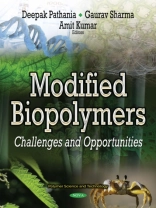Biopolymers such as cellulose, lignin, starch, pectin, chitin, xylan, etc. are copiously available in nature in the form of plant biomass. They have been used for various applications such as biofuels, nanobiocomposites, biomedicine, etc. Biopolymers have unique antimicrobial properties, and are thus used for food packaging. The field of biomaterials is interdisciplinary and includes chemistry, biology and medicine. There are different ways to apply biopolymers for the benefit of our society. Although natural polymers are cheap and available in large quantities, it is still difficult to utilize their potentials. Still, there are challenges to develop new methodologies for the efficient and economic utilization of these biopolymers. Consequently, the modification of these materials is the focus of recent scientific research. These modifications improve the various properties of biopolymers required for specific applications. Modifications improve heat, moisture resistance, solubility in water, sustainability, flexibility, compatibility, biodegradability, etc. Biopolymers modified by blending shows considerable improvement in the impact resistance of brittle polymers. Biopolymer systems containing particles with one or more dimensions in the nanometer scale are called bionanocomposites, a special class of materials possessing unique thermal stability, fire resistance, mechanical and optical properties. Bionanocomposites have been effectively used in controlled drug delivery, food packaging, etc.
Amit Kumar & Deepak Pathania
Modified Biopolymers [PDF ebook]
Challenges and Opportunities
Modified Biopolymers [PDF ebook]
Challenges and Opportunities
Dieses Ebook kaufen – und ein weitere GRATIS erhalten!
Format PDF ● Seiten 328 ● ISBN 9781536121377 ● Herausgeber Amit Kumar & Deepak Pathania ● Verlag Nova Science Publishers ● Erscheinungsjahr 2017 ● herunterladbar 3 mal ● Währung EUR ● ID 7217184 ● Kopierschutz Adobe DRM
erfordert DRM-fähige Lesetechnologie












